Normally I take myself away at Christmas. This year, due to the financial climate and it being a tough year, I’m staying at home. The family is delighted. My intention is to use these unusual circumstances to catch up on some blog writing although I can be easily distracted. The first one on my ‘to do list’ was from a trip made two years ago to New York at Christmas time!!! Normally, I love to get away to the sun, but, due to an action packed 2016, I had left it too late to organise a trip to some exotic location. So, after some quick research, I got a good flight deal and booked an AirBnB and I was sorted.
Often referred to as the greatest city in the world, I had to see if there was any truth in this. After spending a week in between Christmas and New Year in this iconic destination, I left soul searching and reflecting at the failure, on some levels, of a failed Christmas getaway. A lover of all genres of music, sadly the one that sticks in my mind is Jay-Z’s rap ‘concrete jungle where dreams are made of’. To my mind there is no better way to describe the place. Its bright lights were wasted on me; the main island was devoid of any natural beauty and was a fitting illustration of the faceless, globalisation and destruction of the modern world. People and cars fight like animals for their ownership of the jungle; the famous yellow taxis swarm about like bees, advertisements crawl like weeds over the towering, tree like skyscrapers but shorn of any branches. As animals (and some humans) worry about their habit becoming extinct, perhaps the never-ending building works crystallises those concerns.
My arrival in America via New York was not at all friendly or very warm which, considering this is one of the most visited places on earth, was incredibly surprising. Are tourists so excited to be here that they are blinded and unable to see this unwelcoming sight? Police, guns, dogs etc. – as cold and unwelcoming as the airport was (in particular the passport control) the complete opposite could have been said of my AirBnB hosts whose warm and friendly kindness will never be forgotten. They patiently waited for my arrival and duly welcomed me into their family home and made me a part of it as they celebrated Christmas. This is the one extremely positive side to my time in New York and must offset my lack of enthusiasm for the city itself. Maybe teenagers and wannabees can hack it, but I couldn’t.
It is sometimes described as the financial capital of the world and this is reflected in the lifestyle of the city’s inhabitants/commuters. Comparisons could easily be made to parts of London but somehow, despite the similar, relentless, pursuit of money and the ‘benefits’ that it brings, there is a charm about London that doesn’t exist in NYC. The financial sector of any city seems a million miles from the reality of which I am accustomed. A city where money talks, everything seemed overpriced and so far-fetched. Stumbling upon the financial district after a long and beautiful stroll along the river, I had completely forgotten the tragic events that stopped, captivated and changed the world forever in 2001. Perhaps because it is relatively modern history it seems to attract more interest especially from the younger element. It was a tragic day – there is no denying that. I can recall that fateful day as an adolescent 15 year old, coming in from school and hearing the sad news beating over the radio. I was blissfully unaware at that time of the seriousness of that event; surprisingly, I found that I had little interest in the ‘ground zero’ memorial. The very title seems to demean the catastrophe. Perhaps all this is a selfish coping mechanism for the sad state of affairs that exists in this world and I care to forget about it to concentrate on the good things to enjoy.

The city is alive with hustle and bustle. This is not an attractive atmosphere as its over-crowded sidewalks is but one of its many problems. There are too many cars are on the roads and a failed pedestrian crossing system exacerbated the feeling that not enough care had been taken for those who wanted to get around the jungle by foot. The dirt and smell just adds rancour for a place that is too congested and far too big for itself.
I’m sure that people will rave about the Christmas decorations and, while I wouldn’t disagree that they were often spectacular, their appeal didn’t stretch as far as me and sadly are a confirming sign of the commercialisation and forgetting of yet another religious festival. Frankly, what have nutcracker figurines to do with Christmas?
My love for a pint is probably well known by all and the local brew is always sampled on my travels. As pubs seem to be closing at an alarming rate back home, it also seemed a real struggle to find a proper bar in NYC. Drinking on the other side of the ocean was a complete eye opener for me, waitressing/tipping etc. and one that I still can’t get my head around.
I think we can all agree that my passion for sport is second to none. I felt it was only right that I got to enjoy some of the sport the city has to offer. I was desperate to see a NFL game. I wanted to witness and work out what the fascination with this sport was. I mean they call it football but predominantly use their hands!! Instead I had to settle for a ticket to the famous Madison Square Gardens to watch the NY Rangers host an ice hockey game. Their opposition was the Ottawa Senators, the only hockey team I had really heard about, and I was a proud owner of their jersey. Sadly, my jersey stayed hidden in my bag as I was unsure whether opposing supporters mixed in.
There were 3 things that stuck out for me. Firstly the lack of atmosphere was sobering. Secondly, the need for a time out when there are 2 intervals seemed over the top and timewasting. Finally, the fact that the broadcaster could stop a game for an advert break beggared belief!!! Attending football matches back home I couldn’t understand how the NY experience lacked singing before/during/after the game and only a cheer when a goal was scored. Everything seemed flat. People were more worried about capturing the event on their phone and what little atmosphere there was had to be generated by a deafening music system, flashing lights and a DJ. It’s getting a bit like it over here now with the emphasis on money and money making. English football is going the same way as our increasing number of American owners influence our great game. Not understanding the rules of the sport I couldn’t work out why timeouts were/are needed full stop. When I was informed that the broadcasters had put a pause in play for adverts I was aghast. This confirmed my long-established opinion that, as great as TV coverage is, it has ruined sport. I left not really sure what I had witnessed but I am given to understand it was a 4-3 win for the Rangers.
Travelling has always provided the opportunity to meet new people and it was with great pleasure I could catch up with one here. My fellow traveling buddy suggested watching a show. How incredible and now I can tick this experience off the list. The choice of Broadway show was ‘The Colour of Purple’. It was a slight struggle to understand it but didn’t deter from an excellent spectacle played out by a superb cast giving a great performance. I was mesmerised as I had to concentrate so much on trying to understand the language/accent being used. Afterwards I was taken to Times Square – this gimmick may be for the modern fool, but I am not one. I obliged for the customary and mandatory photo and couldn’t wait to get out of there.

I think that, looking back, my favourite part of New York City was pier 16! What was perhaps once the arrival dock for all boats was a fascinating take on the city’s past. New York was once the arrival destination for those who harboured thoughts of chasing the American dream and in their pursuit of this had arrived on these shores.
What was once perhaps the gateway to America, the place where all your dreams were to come true, your ship would have passed France’s gift to the New York landscape, the Statue of Liberty. Not that inspiring, but good views can be accessed from the Staten Island ferry if you don’t want to pay the fee to visit. And as for American dreams, do these even exist anymore?

So, my first visit to America didn’t make a good impression, I was very glad to leave, and let’s hope that the next time is a more positive experience.



















































